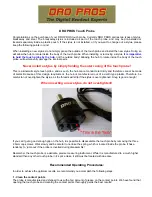
Step 5
–
The 8MHz Crystal
The crystal (Y1) is non-polarised and may be soldered down in either orientation. The PCB footprint
has been designed to make hand soldering easier, however despite this the SMD crystal package can
be tricky to solder.
The best way to solder this component is to place it onto the untinned pads as shown in the image
above. Apply the soldering iron to the exposed section of one of the pads and apply solder. The
solder will wick under the crystal and bond to the pad on the underside.
Remove the soldering iron and allow the solder to solidify. Verify that the crystal is stuck to the PCB
by the pad you just soldered. Once this is done, apply the soldering iron to the other pad to repeat
the same process.






































